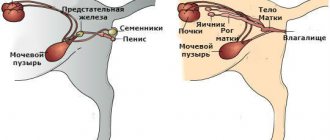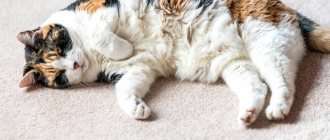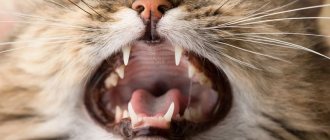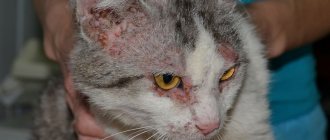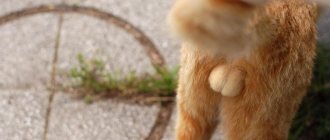Knowing the structure of the reproductive system of the cat family, it is easier for the owner to understand the behavior of his pet. The genital organs of cats are similar to those of other mammals, but they have characteristic features. The anatomy and functions of the male and female differ, but wise nature ensured that their organisms matched “like a key to a lock.” Sexual instinct is the most ancient and primary, because it promotes procreation.
Anatomy of the female reproductive organs
The reproductive system of cats is represented by external and internal genital organs. The first include the vestibule of the vagina, the entrance to the vagina, the labia covering it, the clitoris, the vagina:
- The genital slit is located on the perineum and directly passes into the vagina.
- The vagina is a hollow organ necessary for copulation.
- The clitoris is an undeveloped version of the penis in females. A cat's egg is able to ovulate only after its stimulation during mating.
- The genitourinary system ends in the vestibule of the vagina.
Unlike humans, cats can ovulate several eggs at once, so multiple pregnancies are common for them.
The internal genital organs are located in the abdominal cavity and include the uterus with the cervix, 2 fallopian tubes and 2 ovaries located on either side of the uterus:
The animal's future offspring develop inside the uterus.
- The uterus is a fetal receptacle, a muscular organ that has 2 horns, so it looks like the letter “Y” of the Latin alphabet. In the lower third, the horns unite into a body, which, tapering, passes into the neck. Part of the latter is located in the vagina.
- Fallopian tubes (oviducts) - extend in both directions from the horns of the uterus, ending in wide funnels close to the ovaries.
- The ovaries are hormone-producing organs and are shaped like beans. Follicles (vesicles filled with biological fluid) are formed in their tissue. After the follicle wall ruptures, ovulation occurs—the release of the egg. The rupture site is scarred and a corpus luteum is formed there.
Digestive system
The cat's digestive system consists of:
- esophagus;
- stomach;
- small intestine;
- duodenum;
- jejunum;
- liver;
- large intestine.
The esophagus has a hose-like shape of a relatively small size, and connects the animal’s mouth and its stomach. The esophagus originates from the inner base of the mouth, extends through the neck and chest, passes close to the heart, extends through the muscles of the diaphragm, and connects to the stomach. It is important to note that the esophagus is equipped with special muscles that push food into the stomach, producing synchronous movements similar to waves. The esophagus is one of the most difficult organs in terms of surgical treatment, as it is difficult to access and extremely difficult to heal.
The structure of the cat's genital organs
The male reproductive system includes the testicles and their epididymis, scrotum, spermatic cord and vas deferens, penis, prostate gland, bulbourethral gland, urethra (urethra):
- The testes (testicles) are located in the skin container - the scrotum. It is located outside, below the anus. The situation is explained by the fact that in order to produce full-fledged sperm, a temperature lower than in the abdominal cavity is required. The testicles produce the hormone testosterone, which is responsible for the “male” behavior of the cat.
- The epididymis is a kind of “storage chamber” for the maturation of sperm, because they are formed throughout life. The peculiarity is that they are 2-3 meters long and are rolled up. Moving along the vas deferens, male reproductive cells enter the urethra.
- The urethra is the urinary duct that opens into the penis. Through it, sperm enters the cat's vagina or through urine out.
Elements of the reproductive system of cats have some features characteristic only of the cat family.
The prostate gland is located at the junction of the vas deferens with the urethra and forms a secretion that dilutes sperm in the urinary canal. The bulbourethral glands secrete pre-ejaculate, which facilitates the movement of sperm through the urethra. The penis is an external organ, the head of which is covered by a fold of skin. Its function is to introduce sperm into the female’s vagina. The anatomy of a cat's penis has a peculiarity - keratinized papillae. During copulation, they provide stimulation to the cat's clitoris.
Endocrine system
The endocrine system is primarily responsible for hormones and their production in the corresponding organs. Thus, the cat’s brain produces antidiuretic hormone, oxytocin, corticotropic hormone, adrenocorticotropic hormone, cortisol and growth hormone.
The adrenal glands produce a lot of other hormones, the main purpose of which is to regulate metabolism, and are also responsible for behavioral characteristics. The adrenal glands also produce cortisol, a small portion of testosterone, as well as epinephrine and norepinephrine.
There are a number of other glands of external and internal secretion, the principle of operation of which is common to all mammals.
Development and maturation
The centers of regulation of the reproductive system are located in the brain and, through hormones, send signals to target organs - the ovaries and testes. They, in turn, produce sex cells - eggs and sperm, as well as sex hormones. A gradual increase in their production leads to sexual maturation of individuals. The development and function of the feline reproductive system is influenced by a variety of factors:
- seasonality;
- temperature regime;
- nutritional features;
- belonging to a certain breed;
- conditions of detention and care.
Before fertilization, the cat must become biologically adult.
Sexual maturity is defined as the ability to reproduce one's own kind. In males it occurs at 6-8 months of life, in females - a little earlier and is characterized by the 1st estrus. The general development of the body has not yet been completed, so early pregnancies will be defective. For breeding the breed, the best age is 8-9 months, when the cat’s weight is at least 70% of the weight of an adult and the physiological maturity of all organs and systems begins.
Nervous system
The nervous system of cats is divided into central and peripheral. Each of these systems in a cat performs functions that are standard for most mammals.
The central nervous system consists of the brain, brain stem and the so-called spinal cord. The central nervous system is the most important in the body of any living creature, and simple and complex reactions, as well as some reflexes, depend on it. In addition, the central nervous system interacts with the peripheral and autonomic ones, ensuring their functioning and control.
The peripheral nervous system is responsible for the cat's conscious motor abilities. So, thanks to this system, a cat can move its paws, extend its claws, run, and generally lead the lifestyle that it leads. Also, the peripheral nervous system transmits pain impulses to the central nervous system from any part of the body where peripheral nerve endings are present.
Reproduction
The cat is a polycyclic person. This means that readiness to conceive offspring appears at a certain time. They are called sexual cycles. They are characterized by physiological changes throughout the body caused by hormones. In cats, such a seasonal dependence is not observed. He is always ready for fertilization. Although in the spring they have a high concentration of sperm, which increases their activity. If a cat mates with several males, the litter will contain kittens from different fathers. The female becomes pliable, restless, walks slowly with her tail raised, and rubs near her legs. The cat is ready to be accepted for mating. Soon, estrus occurs, which is the release of mucus from the vagina.
Predisposing behavior of a cat towards a cat arises as a result of irritation of centers in the brain and marks sexual heat.
Sexual arousal in a cat is manifested by “concerts”, running away from the cat. Therefore, mating of fluffy ones is recommended to be carried out on the territory of the male. Full readiness for mating is signaled by the female's stance with her rear raised and her tail moved to the side. The cat covers the cat, holding it by the withers. The act lasts about 5 seconds. The end is marked by the cat screaming and the male jumping away. The cat, lying on its back, sways. Ovulation occurs one day after coitus. If conception does not occur, a period of rest begins until the next estrus. The intervals between them are variable and depend on many factors.
Circulatory system
The circulatory system in cats works the same way as in other mammals: the heart pushes blood through arteries that have elastic walls and rhythmically carry out contraction and relaxation movements. It is thanks to such movements that arteries located close to the skin can be felt, and this is called the pulse. The cat's pulse is easiest to detect on the inside of the thigh, and in a healthy animal it should range between 100-150 beats per minute.
The cat's brain absorbs 15-20% of the blood, the muscular system absorbs up to 40% of the total blood, and about 25-30% of the blood goes to the internal organs. During physical activity, muscles can absorb up to 90% of the blood, which is why cats get tired so quickly, but can focus maximum strength for a short period of time.
The animal's heart is a hollow organ located in the chest, just behind the breastbone. An important nuance is the fact that the weight of a cat’s heart depends on their weight, and does not have clearly established standards. Most often, the heart of an animal weighs 0.6% of the total body weight. The cat's heart consists of 2 ventricles and 2 atria.
What should you take with you?
Simply taking your pet to mating is not enough; you need to take care in advance to ensure that the cat’s “wedding” is successful. Remember that the female will end up in someone else's territory, where she should feel more or less comfortable. In order for the cat to calm down at least a little, do not forget to take with you her rug, on which she is used to sleeping; the familiar smell will have a beneficial effect on her nervous system. It would also be a good idea to take her favorite food, a comb and, if possible, a tray. You can also grab your favorite toy, which the “bride” can distract herself with. As for the male, he will need a rubber bedding so that his paws do not slip during mating.
Cats control you
© Salvo Bombara
This fact will be confirmed by all cat owners without exception - pets do not just meow and purr, but in this way try to establish communication with the owner. In the process of evolution and living side by side with people, these cunning creatures have developed a cry of a special timbre, which a person perceives as unbearably shrill and disgusting. Of course, cats most often use this method of training people when they want to get something edible and, as a rule, achieve the desired result.
Cats are much more careful in lapping than dogs.
© www.wodumedia.com
Instead of simply scooping up water with its tongue, as a dog does, a cat, when lapping milk or other liquid, touches the surface with the rough tip of its tongue and draws it into the mouth along with the resulting column of liquid, closing its jaws to prevent moisture from escaping.
A cat can lap at a rate of four times per second, receiving about 0.1 ml of liquid each time - so it can drink about 5 tablespoons (24 ml) per minute.
Features of the first mating
The first mating between male and female cats is carried out with an experienced partner. This is equally important for both males and females, since the lack of experience affects the result. Be prepared to face difficulties the first time. In the event of force majeure, you will have to help your pet cope with stress or sudden aggression.
In the future, males and females are mated up to 3 times every 2 years. More frequent births are dangerous for the female’s body. The first 6-8 years of life are also considered the optimal time for pregnancy. After this age, females are sterilized and excluded from breeding. A frequency limit is also imposed on cats, since too frequent sexual intercourse reduces the quality of sperm, which means the kittens will be born weaker.
Why doesn't pregnancy occur?
Unfortunately, it also happens that even after several meetings, fertilization of the female does not occur. The reason may be the cat's infertility, but if he has previously mated successfully, then it is necessary to examine the cat. What might be the results?
- The cat is either obese or malnourished;
- Obvious problems with the reproductive system;
- Stress that becomes chronic;
- Any viral diseases are possible;
- Deficiency of minerals and vitamins in the diet:
- Failure in the body's hormonal system;
- The mating was simply carried out at the wrong time.
Cats live for 10 minutes
© www.followthewabbit.com
Cats are able to remember any obstacle in their environment for only about 10 minutes - this is the conclusion made by experts based on the results of a study conducted in 2007.
During the experiment, scientists created artificial barriers that furry subjects had to overcome. It turned out that if you stop a cat after it has stepped over an obstacle with its front paws and do not allow it to continue on its way for 10 minutes, the animal forgets that it is necessary to step over the barrier with its hind paws too, although if you stop it for a short time, the barrier will be “taken” practically straightaway.
The visual memory of cats is much shorter than the muscular memory - if you distract the pet from an obstacle before it begins to overcome it, the cat forgets about the unsolved problem.
...but cats are still intelligent in their own way
© www.mashable.com
Let dogs interact much more actively with people, do not assume that cats can only eat, sleep and force you to regularly change the litter in the cat litter. Domestic cats, like their relatives living in the wild, have all the necessary skills to, for example, outsmart prey or deceive an enemy.
In 2010, Wildlife Conservation Society staff managed to film the hunt of the long-tailed margay cat, which lives in the Amazon forests. Wanting to get one of the small tamarin monkeys for dinner, the cat quite accurately imitated the cries of these animals, and when some of the tamarins got closer, she set up an ambush. Only the warning cry of the leader saved one of the monkeys from reprisal, but it can be assumed that in the end the patient margay finally achieved her goal, or went off to look for other, less capricious prey.
Cat parasites can turn you neurotic and kill you
Toxoplasma gondii
Cats are capable of not only controlling people, but also infecting them with parasites that directly affect the human personality. Microorganisms of the species Toxoplasma gondii are transmitted to cats from rats and mice, which, under the influence of this parasite, behave very recklessly and themselves look for places where they can encounter cats. If a furry pet manages to eat an infected mouse, the microbes will most likely appear in its owner, which is fraught with the development of toxoplasmosis , a disease that can noticeably change a person’s behavior.
A study conducted in 2006 found that after infection with Toxoplasma gondii, people's anxiety levels increase, their reactions slow down, neurotic traits appear, and for a person with a weak immune system, toxoplasmosis can even become fatal.
Help from the owners
Mating is a natural process, but despite this, animals require the attention of their owners. And, in order not to wonder why the cat does not mate with the cat, mating should be controlled. Remember that this process requires maximum patience.
- Show you care. Do not rush your pets, do not push them towards each other - this will only aggravate the situation. The “newlyweds” must reach a certain stage themselves.
- Never raise your voice at your pets if you see that they are unable to come to an agreement. It is quite possible that they simply could not “agree.”
- If you see that potential partners have already moved on to a “showdown,” you can stop the meeting. There’s no point in expecting that they’ll get along anyway.
- If intimacy occurs, control the situation. The female may need your help if she begins to fall on her side, limiting access to her partner.
- After the successful completion of the “date,” carefully examine the female for wounds, since the male, in a fit of passion, may accidentally leave scratches on the cat.
